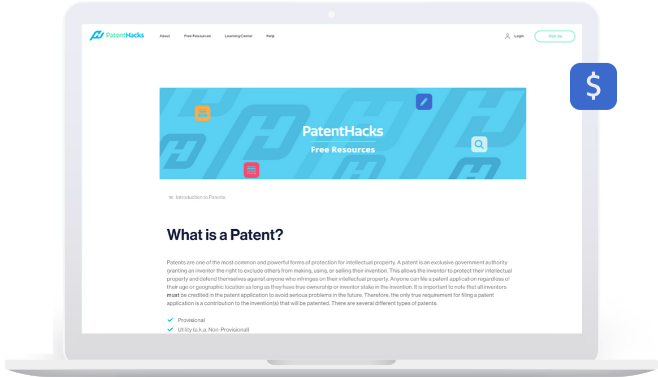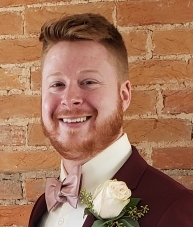The Patent Hacks® Learning Center is an all-in-one do-it-yourself tool that walks you through the entire patent application process.
We define patent-related terms throughout our platform, so that anyone can be successful regardless of their experience level.
Our Learning Center is designed with a simple, straightforward, and familiar “ebook” style layout.
A Patent Hacks® Learning Center subscription is less than 1% of the cost of all other patenting options.
We teach you how to navigate every step of the patent application process with 50+ step-by-step guides, 30+ templates, and 500+ real-life examples.
Learn how to perfect repeatable patenting processes so you can create unlimited patent applications on your own instead of spending $20,000+ per patent application.

The Patent Hacks™ Learning Center is an all-in-one tool that walks you through the entire patent application process.
The Patent Hacks™ Learning Center is an all-in-one tool that walks you through the entire patent application process.
Sign up to gain access to the Patent Hacks® Learning Center.
Learn how to validate, prepare, and file your own patent applications.
Put your new knowledge to work and build the perfect patent applications.
Secure protection for your intellectual property and build the foundation for a successful business.





Our founders have all created inventions at various points in their lives, and they ran into the same problems as you. There's nothing more demoralizing than getting excited about your great new idea, and then finding out it will cost $10,000+ just to protect it...
If you’ve had that eureka moment, you’ll no doubt want to make sure that you’re protected by patent law before you start working on your idea.
However, it is worth discussing if you can even patent an idea.
The short answer to that question is no. If you are attempting to patent something that is just an idea, then it won’t happen. However, it is possible to patent an idea once it has become an invention.
So, how do you protect your idea?
Let’s explore these concepts and discuss how you should protect yourself when you’re creating something new and exciting.
Before finding out how to get a patent on an idea, you must understand the difference between an idea and an invention.
All inventions start with an idea. However, it is important to point out that not every idea is an invention, and that not every idea could be turned into one.
For an invention to be patented it needs to be patentable subject matter, useful, nonobvious, and original at the very least. It is not enough to say that you have come up with an idea for an invention, you would need to be able to show that it actually works.
For example, you could come up with an idea for a flying car, but unless you can demonstrate through your plans that you know how you would make the car fly, then your patent would not be granted.
It is essential that you know all about patents and how they work before you apply for one. It will save you time and money, and ultimately ensure that your invention is properly protected.For more on this please visit our Learning Center.
A patent allows you to register ownership of your invention. It is a property right granted by the federal government that allows you to prevent other people from making, altering, or selling your invention while your patent is active.
If you have a patent in place, it means that you can take legal action against anyone that steals or attempts to make money using your inventive concept(s).
In the United States, patents are looked after by the United States Patent and Trademark Office (USPTO).
However, the USPTO will only grant patents that meet a specific set of criteria.
Even if you have a useful and unique invention that is either a machine, process, manufactured items, or compositions of matter, you cannot get a patent if it is:
As long as your idea does not fall into one of these three areas, then it should be capable of being patented.
The criteria for each type of patent will differ, as will the length of time that it is active. In addition to differing timescales, there are also different maintenance fees associated with each type of patent.
From the date of the application, the utility patent lasts for a total of 20 years. To protect your invention for the full 20 years, you will need to pay maintenance fees throughout the life of the patent. This could be quite expensive; however, it is worthwhile for the protection it provides.
After the 20 years are up, it might be possible to extend the protection, however, this will depend on the circumstances. Extending a patent beyond 20 years is quite rare.
Design patents only last for 14 years from the date that the application is accepted. Unlike the utility patent, there are no maintenance fees attached to design patents.
While a design patent may seem like a cost-effective option, you should consider the fact that a design patent does not protect the function of the invention, just the aesthetics.
For plant patents, there is 20 years of protection, and there are no maintenance fees.
Once you have your invention patented, you might worry about manufacturers from other countries making copies of your invention. With the potential for lower-cost manufacturing, there would be a risk that these copies could really damage your sales.
Where do you stand with your invention’s patent internationally? Is there an international patent law?
Regrettably, United States patents will not protect your invention outside of the U.S. Although it could be argued that there are clear grounds for international patent laws, unfortunately, such a thing doesn’t exist.
Patent laws will differ between countries. There might be some universal aspects that apply to many countries, but not all of the points in United States patent law are applicable everywhere.
Researching the specific laws of the countries that you want to extend your patent to is essential.
There is, however, the Patent Cooperation Treaty . This makes the process of patenting your invention overseas a bit more straightforward.
The Patent Cooperation Treaty allows you to file patents across many different countries all at once through an international patent application.
If you are filing a patent in another country, you should keep in mind that you will need to pay maintenance fees for that country. This will vary, and you might have different tax obligations within that country.
With all of the complexity surrounding international payments and taxes, you should seek the assistance of an accountant.
While you cannot officially file a patent for a name, you can register a trademark for one.
Businesses often seek a trademark for the name of their company. A trademark can be filed through the United States Patent and Trademark Office and it protects your company name from being used without your consent.
However, this protection only applies for when someone is referencing your company, especially in situations where your company name contains common words. This is an important distinction because many companies use common words in their trademark, which means some overlap is possible.
It is difficult to patent an idea. You need to be able to prove that your idea can function and that you know how to make it meet its intended purpose.
In addition to this, there will be many other requirements that your invention must meet before a patent can be granted. This makes the process of applying for a patent both long and tedious. Not only that, but you’ll need to get your head around some tricky legal concepts.
Patent Hacks:Learning Center is here to help. With a wide range of resources, we can provide you with the information that you need to ensure your patent application is a success.
Copyright © 2021 Patent Hacks™.
All Rights Reserved.
Terms of Use | Privacy Policy | Scholarship
Disclaimer: Communications between you and Patent Hacks are protected by our Privacy Policy but not by the attorney-client privilege or as work product. Patent Hacks provides access to independent attorneys and self-help services at your specific direction. We are not a law firm or a substitute for an attorney or law firm. We cannot provide any kind of advice, explanation, opinion, or recommendation about possible legal rights, remedies, defenses, options, selection of forms or strategies. We do not provide any guarantee of obtaining patent protection. Your access to the website is subject to our Terms of Use.
Copyright © 2024 Patent Hacks®.
All Rights Reserved.
Terms of Use | Privacy Policy | AI Terms of Service | Pricing | DEI Program
Disclaimer: Communications between you and Patent Hacks are protected by our Privacy Policy but not by the attorney-client privilege or as work product. Patent Hacks provides access to independent attorneys and self-help services at your specific direction. We are not a law firm or a substitute for an attorney or law firm. We cannot provide any kind of advice, explanation, opinion, or recommendation about possible legal rights, remedies, defenses, options, selection of forms or strategies. We do not provide any guarantee of obtaining patent protection. Your access to the website is subject to our Terms of Use.
By using our website or platform you are agreeing to our Privacy Policy and Cookies Policy. You can review our Privacy Policy and Cookies Policy here.
By using our website or platform you are agreeing to our Privacy Policy and Cookies Policy. You can review our Privacy Policy and Cookies Policy here.
By using our website or platform you are agreeing to our Privacy Policy and Cookies Policy. You can review our Privacy Policy and Cookies Policy here.